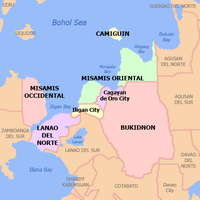
Mindanao is the second-largest island in the Philippines, after Luzon, and seventh-most populous island in the world. Located in the southern region of the archipelago, the island is part of an island group of the same name that also includes its adjacent islands, notably the Sulu Archipelago. According to the 2020 census, Mindanao has a population of 26,252,442 people, while the entire island group has an estimated population of 27,021,036 according to the 2021 census.

Misamis Occidental, officially the Province of Misamis Occidental, is a province located in the region of Northern Mindanao in the Philippines. Its capital is the city of Oroquieta. The province borders Zamboanga del Norte and Zamboanga del Sur to the west and is separated from Lanao del Norte by Panguil Bay to the south and Iligan Bay to the east. The province of Misamis was originally inhabited by Subanens who were an easy target by the sea pirates from Lanao.
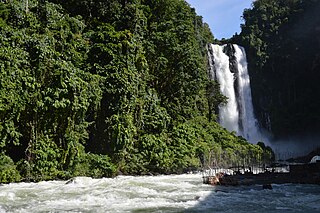
Lanao del Norte, officially the Province of Lanao del Norte, is a province in the Philippines located in the Northern Mindanao region. Its capital is Tubod.

Misamis Oriental, officially the Province of Misamis Oriental, is a province located in the region of Northern Mindanao in the Philippines. Its capital, largest city and provincial center is the city of Cagayan de Oro, which is governed independently from the province.

Camiguin, officially the Province of Camiguin, is an island province in the Philippines located in the Bohol Sea, about 10 kilometres (6.2 mi) off the northern coast of mainland Mindanao. It is geographically part of Region X, the Northern Mindanao Region of the country and formerly a part of Misamis Oriental province.
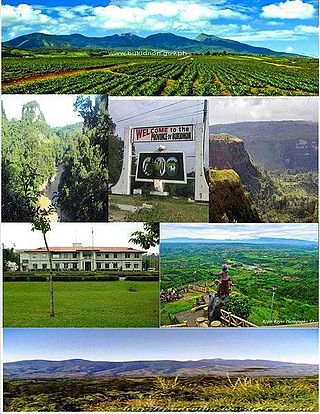
Bukidnon, officially the Province of Bukidnon, is a landlocked province in the Philippines located in the Northern Mindanao region. Its capital is the city of Malaybalay. The province borders, clockwise from the north, Misamis Oriental, Agusan del Sur, Davao del Norte, Cotabato, Lanao del Sur, and Lanao del Norte. According to the 2020 census, the province is inhabited by 1,541,308 residents. The province is composed of 2 component cities and 20 municipalities. It is the third largest province in the country in terms of total area of jurisdiction behind Palawan and Isabela respectively.

Lanao del Sur, officially the Province of Lanao del Sur, is a province in the Philippines located in the Bangsamoro Autonomous Region in Muslim Mindanao (BARMM). The capital is the city of Marawi, and it borders Lanao del Norte to the north, Bukidnon to the east, and Maguindanao del Norte and Cotabato to the south. To the southwest lies Illana Bay, an arm of the Moro Gulf.

Iligan, officially the City of Iligan, is a 1st class highly urbanized city in the region of Northern Mindanao, Philippines. According to the 2020 census, it has a population of 363,115 people.
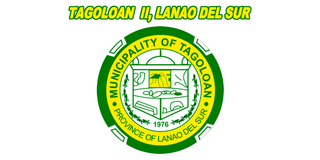
Tagoloan, officially the Municipality of Tagoloan and also known as Tagoloan II, is a 4th class municipality in the province of Lanao del Sur, Philippines. According to the 2020 census, it has a population of 12,602 people.
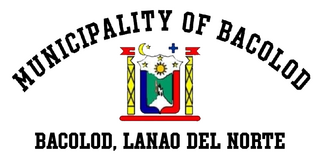
Bacolod, officially the Municipality of Bacolod, is a 4th class municipality in the province of Lanao del Norte, Philippines. According to the 2020 census, it has a population of 24,367 people. The town is home to an old Spanish fort, known as Fuerza de Bacolod, which is in dire need of proper conservation and faithful restoration by the National Museum of the Philippines.

Kauswagan, officially the Municipality of Kauswagan, is a 5th class municipality in the province of Lanao del Norte, Philippines. According to the 2020 census, it has a population of 24,193 people.

Linamon, officially the Municipality of Linamon, is a 5th class municipality in the province of Lanao del Norte, Philippines. According to the 2020 census, it has a population of 21,269 people.
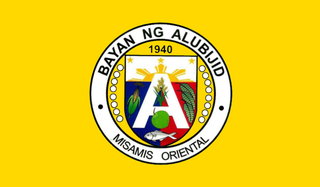
Alubijid, officially the Municipality of Alubijid, is a 4th class municipality in the province of Misamis Oriental, Philippines. According to the 2020 census, it has a population of 32,163 people.

Initao, officially the Municipality of Initao, is a 3rd class municipality in the province of Misamis Oriental, Philippines. According to the 2020 census, it has a population of 33,902 people.

Lugait, officially the Municipality of Lugait, is a 2nd class municipality in the province of Misamis Oriental, Philippines. According to the 2020 census, it has a population of 20,559 people.

Opol, officially the Municipality of Opol, is a 2nd class municipality in the province of Misamis Oriental, Philippines. According to the 2020 census, it has a population of 66,327 people.
Maria Cristina Airport, also known as Iligan Airport, is an airport serving the general area of Iligan, located in the province of Lanao del Norte in the Philippines. It is the only airport in the province. The airport is classified as a secondary airport, or a minor commercial domestic airport, by the Civil Aviation Authority of the Philippines.
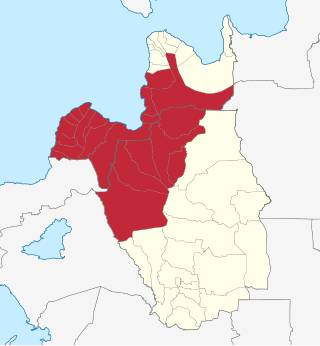
Metropolitan Cagayan de Oro, also known as Metro Cagayan de Oro, is the fourth largest metropolitan area in the Philippines. It is located on the northern coast of Mindanao, and comprises the two chartered cities of Cagayan de Oro and El Salvador and the fourteen municipalities of Misamis Oriental which are Alubijid, Balingasag, Claveria, Gitagum, Initao, Jasaan, Laguindingan, Libertad, Lugait, Manticao, Naawan, Opol, Tagoloan, and Villanueva and the six municipalities of Bukidnon which are Manolo Fortich, Baungon, Libona, Malitbog, Sumilao and Talakag. According to the 2015 Philippine census, Metro Cagayan de Oro has a population of 1,687,159 people.
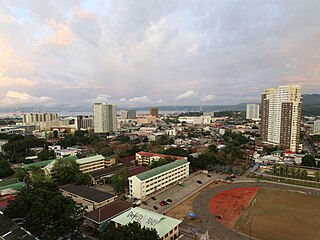
Cagayan de Oro (CDO), officially the City of Cagayan de Oro, is a 1st class highly urbanized city in the region of Northern Mindanao, Philippines. It is the capital of the province of Misamis Oriental where it is geographically situated but governed administratively independent from the provincial government. According to the 2020 census, it has a population of 728,402 people. Cagayan de Oro also serves as the regional center and business hub of Northern Mindanao, and part of the growing Metropolitan Cagayan de Oro area, which includes the city of El Salvador, the towns of Opol, Alubijid, Laguindingan, Gitagum, Lugait, Naawan, Initao, Libertad and Manticao at the western side, and the towns of Tagoloan, Villanueva, Jasaan, Claveria and Balingasag at the eastern side.
The COVID-19 pandemic in Northern Mindanao is part of the worldwide pandemic of coronavirus disease 2019 caused by severe acute respiratory syndrome coronavirus 2. The virus reached Northern Mindanao on March 11, 2020, when the first case of the disease was confirmed in Cagayan de Oro.





































